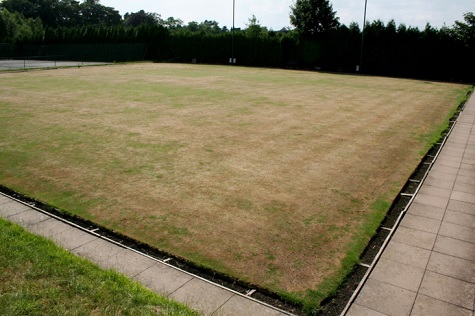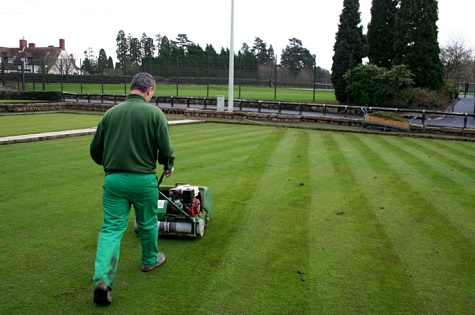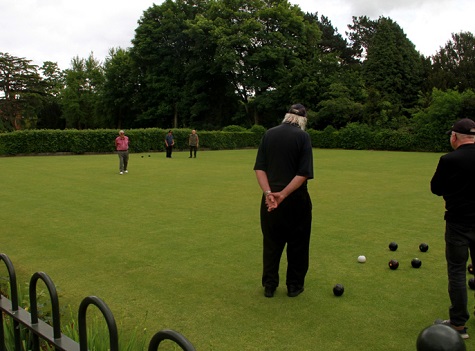Without doubt it has been a very difficult year for many bowling clubs. This year’s extreme hot weather will have played havoc and affected the playability and performance of the green - especially if they had no means of watering it.
I have seen many greens that have completely dried out and become hydrophobic - that is to say they have dried out so much they become difficult to re-wet and this may lead to localised dry patches being formed across the playing surface.
Once the soil becomes hydrophobic, water will lie on the green’s surface for a long time and the soil underneath will remain powder dry and unable to support plant life. The result is large brown patches on the surface where the thatch eventually dries out so much that it becomes hard and brittle.

It will take a lot of hard work and copious amounts of rain to help the green recover from this condition - however with the bowling season now coming to a close, this year’s end of season renovation programme will be a most important one.
The extent and nature of the work will be entirely down to the condition of the green and what work you can afford to carry out. Unfortunately, one of the deciding factors that often reduces the effectiveness of these planned works is the amount of money (budget) the club has available. It can cost anything between £1500-£2000 for a contractor to come in and carry out all tasks.
Savings can be made if the club undertakes the work themselves. However, the effectiveness of the work will be determined by the equipment at their disposal.
Due to the current economic crisis, the cost of seed, topdressings and fertilisers have gone up substantially, with many clubs facing increased costs for this year’s end of season renovations.
The following activities are generally implemented during autumn renovations and usually carried out in the following order:
Mowing the sward: To prepare surfaces for renovation, lower cutting height to about 3-4mm to clean and prepare green for renovation operations.
Scarification: The removal of unwanted debris and collection and disposal of arisings. Depending on the severity of the thatch, you may need to scarify several times in different directions. However, in most cases, if regular verticutting / grooming has taken place during the growing season, you would probably only be required to scarify in two directions.

Aeration: Depending on the turf's condition, you can choose to carry out hollow or solid tine spiking. Hollow tines are generally used on a bi-annual basis or when you have a severe thatch problem. Depth of aeration will be determined by the depth of your soil profile and what problems you want to rectify. Hollow tining is best achieved to a depth of between 75-100mm. Solid or slit tines can be set to penetrate deeper, ideally between 150-200mm.
Topdressing: This restores levels and improves surface drainage. Ensure you use compatible topdressing materials, sands, sand/soil mixes. The amount of dressing required is generally between 1.5-3 tonnes.
Overseeding: This restores grass populations. It is important to ensure a good groove or hole is made to receive the seed; good seed to soil contact is essential for seed germination. Good moisture and soil temperatures will see the seed germinate between 7-14 days.
Fertilising: This provides nutrients for grass growth. Apply a low N nitrogen fertiliser product, something like an NPK 5:5:15 to help the sward through the autumn period.
These renovations are an integral maintenance operation to ensure the green can recover from 2022’s indifferent growing and playing season.
Bowls clubs facing hardship
Many clubs are facing a tough time. Speaking to a friend and ex-England bowler and bowls greenkeeper, he told me he is particularly worried about the current state of the game. The demise of the condition of bowling greens has been dramatic in recent years, with clubs less willing to invest in their greens maintenance - especially when it comes to undertaking end of season work.
I believe the lack of budget at clubs can be attributed to their dwindling membership numbers and the fact that those who do join are not being charged appropriate fees.
Also, on the competitive side there are fewer and fewer decent competitions being organised and over time the general standard of play and etiquette of players has also declined.

I have flagged this up before in several TurfPro articles, that the sport of bowls has been in decline for many years. This can arguably be put down to the truism that a majority of members are in their late 70s and coming to the end of their active lifestyle, coupled with the fact there is no national campaign by the sport’s governing bodies to encourage a new generation to take up the game.
A recent publication Is Lawn Bowls Is A Dying Sport? Or Does It Just Need Reviving? - A Complete Guide on Jack High Bowls explains the reason for sports decline. It says that the number of participants in the UK has dropped by a third since the turn of the millennium.
This is the outcome from poor recruitment and an ever-increasing number leaving the sport, either due to clubs going under, or ill health.
For me it is time that the powers that be come together to find a way of promoting this sport. I believe bowls has many benefits and if given some positive spin and linked to schools curriculums, the sport has a chance to redeem itself and be a valid community pastime once again.